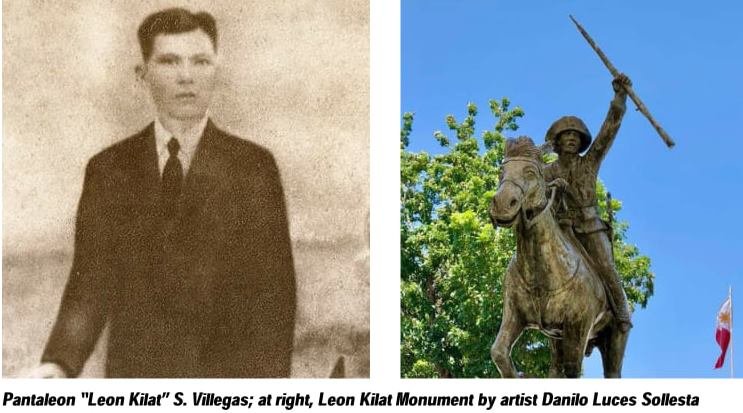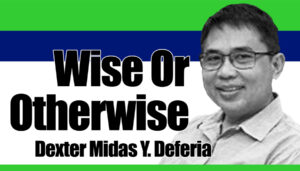- PENN T. LARENA
He may not be considered to be in the league of the country’s renowned national heroes, such as Jose Rizal, Apolinario Mabini, and Andres Bonifacio, but he is a Visayan hero, who fought for the nation’s independence from Spain with the same vigor and passion.
Negros-born Pantaleon Villegas, known as Leon Kilat, led a group of Cebuano Katipuneros in attacking the Spaniards on April 3, 1898, in what is now known as the Battle of Tres de Abril.
In commemoration of the 148th birth anniversary of General Pantaleon Villegas this July 27, a mass will be officiated by the parish priest of St. Augustine of Hippo Parish Church at about 7 a.m. and expected to be attended by town officials of Bacong, headed by Mayor Lenin Alviola, DepEd elementary and secondary schools heads, personnel of the Bacong Municipal Police Station, ACOP, Bureau of Fire Protection, and relatives of Leon Kilat.
The mass will be followed by a floral offering at the shrine of General Pantaleon Villegas at the town plaza. A flag-raising ceremony, in which the PNP and BFP personnel were tasked to raise the nine revolutionary flags, and lead the Tap and the 21 Gun Salute in honor of the hero, will also be held.
Leon Kilat was born on July 27, 1878. He had three siblings – the eldest was Irinea, followed by Silvestra, and Julian, the youngest after Pantaleon. They were the children of Doña Ursula Soldi and Don Policarpo Villegas, a son of sugar baron, Don Pedro Villegas, a pure Spanish, who settled in the hacienda town of Vallehermoso in Negros Oriental.
They became orphans when they were young and Pantaleon became a sacristan at the St. Augustine de Hippo Parish Church, but eventually left Bacong for Cebu.
He worked in a pharmacy initially called “Dispensario Cebuano” then later named “Botica Alemana”, and lastly as “Botica Antigua”. It was situated in the corner of Calle del Palacio (presently, Burgos Street) and Calle Legaspi, and was considered the best pharmacy in Cebu.

Leon, however, did not stay long at the Botica Antigua as he transferred to a bakery owned by Pascuala in Pahina. Leon soon left the bakery and joined a circus from Manila that came to Cebu aboard the ship, “Sotolongo”, owned by a Katipunero.
It was in the circus that Leon Kilat learned of Escrima and other games, like “sepa” and arnis. Leon was eventually entered as a member of the “Consejo Secreta”, or secret society, where magic is taught, among other esoteric talents and skills.
Leon Kilat was awed by the Tagalogs’ bravery and skills, illustrated in the KKK operations in San Roque, Cavite, and the attack in Binondo, and the melee in Malolos.
It was him who inspired into action the KKK of Cebu.
The members of KKK Cebu were Teopisto Cavan, Prisco Abreu, who recruited judge Candido Padilla, Ando Climaco, Jacinto Pacaña, Cabeza Francisco Llamas, Atilano Lopez, Eugenio Ginez, Luis Flores, and Alejo Minoza.
With the help of a Tagalog Katipunero, who was dispatched to Cebu, a local chapter was formed in Cebu City in June 1897, participated mostly by the workers of San Nicolas. While waiting for the designated official to start the revolution, the local Katipunan chapter silently recruited members from different parts of Cebu and Negros.
Leon Kilat, who was 24 years old, was the designated leader of the local chapter. Although a non-Cebuano, he was familiar with Cebu and had several friends there when he had a job in the city for a few years before working in Manila.
Under his leadership, the KKK-Cebu uprising was launched on April 3, 1898.
Leon and the Katipuneros succeeded in forcing the Spaniards to seek refuge at Fort San Pedro and took control of Cebu for a few days.
Unfortunately, Leon was killed five days later in Carcar, Cebu, not by a Spaniard, but by an aide, who was scared of Spanish reprisal.
Tanjayanon heritage advocate, Dr. Gerard Jude Bumanglag, said it’s good to honor Jose Rizal and other national heroes but our local folks should also honor home-grown heroes, who contributed to the development of the history and heritage of the place.
He suggested that each town or city organizes a local historical and heritage council so that they will initiate activities to remember local heroes.
As we remember the birth anniversary of Leon Kilat, we Negrosanons should read and honor his life and legacy in our Visayan history and heritage. – NWI




